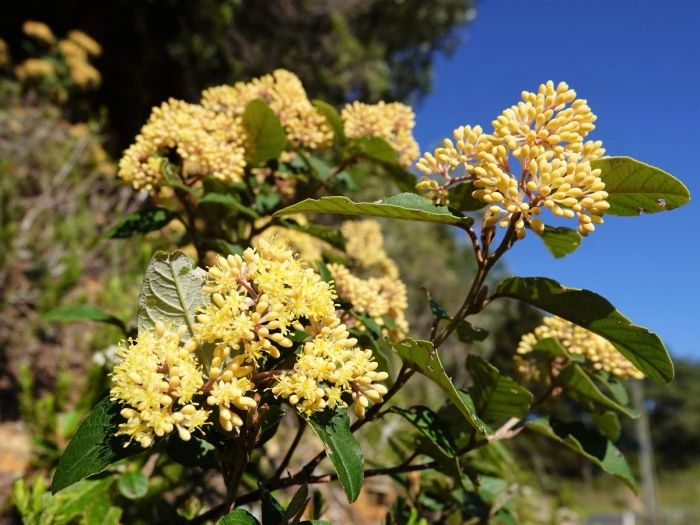Kūmarahou
(Pomaderris kumeraho)
Kūmarahou (Pomaderris kumeraho)
/
/

Jacqui Geux
CC BY 4.0
Image By:
Jacqui Geux
Recorded By:
Copyright:
CC BY 4.0
Copyright Notice:
Photo by: Jacqui Geux | License Type: CC BY 4.0 | License URL: http://creativecommons.org/licenses/by/4.0/ | Rights Holder: Jacqui Geux | Publisher: iNaturalist | Date Created: 2020-09-03T14:17:14-07:00 |

























Estimated Native Range
Climate Requirements for Jakarta, Indonesia
| This Plant | Your Site | Plant Suitability for Your Location | ||
|---|---|---|---|---|
| • Precipitation | 47" - 89" | 81" | Aquatic | Aquatic |
| • High Temp. | 69°F - 77°F | 91°F | Your summers may be too hot for this plant. | Too hot |
| • Low Temp. | 36°F - 50°F | 73°F | OK, but your winter temperatures are warmer than normal for this plant | OK |
This plant may not grow well at your location - your precipitation is too high.
Summary
Pomaderris kumeraho, commonly known as kūmarahou or gumdigger’s soap, is a deciduous shrub endemic to the North Island of New Zealand, particularly thriving in scrubland, along forest margins, and in regenerating kānuka and mānuka forests. It can grow up to 13 feet tall and is characterized by its dense, twiggy form. The shrub produces clusters of small, bright yellow flowers in early spring, typically around September, which are quite showy and attract a variety of pollinators. These flowers have a unique property; when rubbed with water, they create a natural lather, hence the name gumdigger’s soap.
Kūmarahou is valued for its medicinal properties by Māori culture, particularly for treating respiratory ailments and skin disorders, though there is limited scientific evidence to support these uses. In cultivation, it is used for revegetation projects and as an ornamental plant in gardens due to its attractive flowers and ease of maintenance. It prefers well-drained soils, tolerates a range of soil types, and requires full sun to part shade. While generally easy to grow, it can be susceptible to root rot in poorly drained soils. Kūmarahou is not known for being invasive outside its native range and has no significant pest or disease issues. It is a plant of interest for those looking to create a garden with native New Zealand flora or for its potential medicinal uses.CC BY-SA 4.0
Kūmarahou is valued for its medicinal properties by Māori culture, particularly for treating respiratory ailments and skin disorders, though there is limited scientific evidence to support these uses. In cultivation, it is used for revegetation projects and as an ornamental plant in gardens due to its attractive flowers and ease of maintenance. It prefers well-drained soils, tolerates a range of soil types, and requires full sun to part shade. While generally easy to grow, it can be susceptible to root rot in poorly drained soils. Kūmarahou is not known for being invasive outside its native range and has no significant pest or disease issues. It is a plant of interest for those looking to create a garden with native New Zealand flora or for its potential medicinal uses.CC BY-SA 4.0
Plant Description
- Plant Type: Shrub
- Height: 5-15 feet
- Width: 6-10 feet
- Growth Rate: Moderate
- Flower Color: Yellow
- Flowering Season: Spring
- Leaf Retention: Evergreen
Growth Requirements
- Sun: Full Sun, Part Shade
- Water: Medium
- Drainage: Medium
Common Uses
Bee Garden, Bird Garden, Low Maintenance, Showy Flowers
Natural Habitat
Scrubland, forest margins, and regenerating kānuka and mānuka forests
Other Names
Common Names: Gumdigger’s Soap, Kumerahou
Scientific Names: Pomaderris kumeraho
GBIF Accepted Name: Pomaderris kumeraho